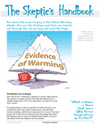Nobody checked the carbon-13 ratios!
Wouldn’t you know it — 150 nations signed the Global Methane Pledge without even bothering to check if the methane was man-made.
Methane — the second most hated Greenhouse gas — spiked to record historic levels in the last few years, over 1,900 parts per billion. In 2019, even the WEF scientists admitted they couldn’t explain the baffling rise, and then in 2020, the world of methane went into the twilight zone. We shut down the modern world due to the pandemic, and methane levels rose even faster.
It seems many have been blaming fossil fuels for the global surge in emissions, but forgot to check the C13 isotopes. Somehow we spend millions on breathalysing cows, measuring their burps, and feeding them seaweed, but didn’t think to do the basic chemistry. How could that be, you might wonder… 158 nations agreed to cut methane emissions by 30% by 2030, but none of them audited the science even though very strange things were happening. (The point was obviously the “pledge”, the junkets, the captive industries and subsidies, anything but the science).
Methane from fossil fuels has a higher carbon-13 ratio, but even though fossil fuel use was rising, the carbon-13 levels of atmospheric methane was rolling down a hill. Indeed this new study shows it’s been falling for 17 years.
It’s not like this snuck up on us…. any inquiring mind should have seen this coming a decade ago. The lab has been recording C13 in methane since 1998 and gets air samples from 22 sites around the world every week or two.

(A) Trend of globally averaged CH4 abundance (in gray) and δ13CCH4 (purple) from the NOAA/GML GGGRN. Mean growth rates of CH4 mole fraction and δ13CCH4 are shown for the following time periods: 1983–1998, 1999–2006, 2008–2014, 2014–2020, and 2020–2022. (B) Colocated δ13CCH4 measurements at Alert (Canada), Svalbard (Norway), and Antarctica by INSTAAR, NIWA, TU/NIPR, and MPI. Each dataset is fitted with a trend in the same color. PNAS
Microbes in environment drove methane emissions more than fossil fuels between 2020 and 2022, analysis finds
They found that between 2020 and 2022, the drastic increase in atmospheric methane was driven almost entirely by microbial sources. Since 2007, scientists have observed microbes playing a significant role in methane emissions, but their contribution has surged to over 90% starting in 2020.
“Some prior studies have suggested that human activities, especially fossil fuels, were the primary source of methane growth in recent years,” said Xin (Lindsay) Lan…
“These studies failed to look at the isotope profile of methane…
They go on to mention that in a warmer world, bacteria have a higher metabolism, which means they are happier and work faster. Thus, like CO2, if the world warms for any reason at all, methane will rise — and there is nothing we can do about it.
The one last straw they could clutch is that maybe the microbes were “man-made” :
It remains unclear whether the increased microbial emissions came from natural sources like wetlands or human-driven sources, such as landfills and agriculture. The team plans to delve deeper to identify the exact source of methane.
As if somehow there was a surge in landfill, rice paddies or cows in the last few years that no one had noticed.
This is a pretty big deal — methane has supposedly caused about 30% of our current temperature rise (says the broken climate models) yet 90% of that recent rise was microbes. It’s yet another slice of the climate we aren’t controlling, but we’re still designing burgers with mealworms and bacon from fungus, in the hope of reducing methane emissions and controlling the weather. Then it turns out every swamp and square meter of soil is working against us.
Methane concentrations in the air have almost tripled since the 1700s, but that was the Little Ice Age. It’s easy to believe that as the world warmed up, the planet’s wetlands and soil microbes have just been returning to normal business for the last 300 years.
We skeptics told the experts long ago it was mostly not man-made, Tom Quirk showed that methane rises and falls in time with El Ninos, and was thus largely a natural phenomenon. Willie Soon also pointed out that one of Saturn’s moons has more methane than all the oil and gas deposits on Earth, but has no dinosaurs, cows or leaky wells.
REFERENCE
Michel, Sylvia Englund, et al (2024) Rapid shift in methane carbon isotopes suggests microbial emissions drove record high atmospheric methane growth in 2020–2022, Proceedings of the National Academy of Sciences. DOI: 10.1073/pnas.2411212121










1900 parts per billion works out at 1.9 parts per million.
at the current alarmist scare level of methane at 85 times as bad as CO2 that means an equivalent of 161.5 ppm of CO2.
Surely someone would notice a big jump in temperature since we are told that would cause Global Warming?
That would generate a bigger scare than this scare.
270
Not necessarilly !
The chart shows a 200 ppb (0.2 ppm) in the 30+ yrs since 1990.
Which would mean an equivalent , ( x85), CO2 increase of 17 ppm, …
…whilst in the same period the recorded CO2 increase has been 70+ ppm
80
By far the biggest greenhouse gas is water vapour (humidity, not clouds), typically 1% to 4%. So 10,000ppm to 40,000ppm. And a far wider range of absorption. A warmer world is a more humid world through increased evaporation. Why would anyone care about something which is 1.9 parts per million?
200
There’s a reason I said it was the second most hated greenhouse gas…
110
The Greens hated and banned another gas. Chlorine. The idea that we tiny humans living in the top 2 metres above the land control gases on planet earth is insane. We have now banned ethane, methane, carbon dioxide, chlorine and oxygen must be next. But hydrogen will save us. It’s like a child’s chemistry.
160
I work in dairy and we haven’t had the seaweed forced upon us yet (to my knowledge). There was an audit done on co2 emissions at some stage, but apparently it was pretty easy or light, because we don’t grow crops they weren’t concerned. I don’t know more detail as I’m not the actual farmer just a worker, it’s just the report I managed to extract.
I occasionally warn him of the coming aggression, but he doesn’t understand this world at all and has even less interest. But I was surprised he passed so easily. We pour the urea on like there’s no tomorrow, it’s all Mr Farmer understands, and the cows live day and night on rye grass. But nope, all okay. I’d say this is just the warm-up stage.
220
Thanks again to Jo Nova for allowing us to gain a further education about the co2 and methane gases.
No doubt that the microbes also thrive in a warmer world, just like Humans have through the use of fossil fuels.
Again their crazy LIA return isn’t something we should be wasting trillions of $ on and we should stop their sick UN fantasy trip ASAP.
180
“have just been returning to normal business for the last 300 years”.
Our environment is not constant and it’s good to remember that. The tiny blip referred to was no doubt caused by some small natural disturbance and I suspect led to the extra interest in moving to a warmer Australia in the 1800s.
An interesting comment I heard yesterday while driving, said that the object which wiped out the dinosaurs was a piece of space junk the size of mount Everest.
CO2 and methane are “organic” and in constant turnover with nature; what we need to be concerned with is the hard pollution from industrial processes which often goes unchecked and can really hurt us.
Batteries being discarded and thrown out somewhere are a major issue at the moment.
160
Rising methane atmospheric concentration is not a good thing because, as we all know, it is a potent greenhouse gas.
MethaneSAT and Copernicus Sentinel-5P will help us detect where the emissions are coming from, but it is still a work-in-progress.
346
Methane concentration has been falling, so it has nothing to do with the burning of fossil fuel.
Water vapour in the stratosphere is a more potent greenhouse gas than methane.
182
Err ?.. that is not what the graph in the heading says !
Where do you get your comment from ?
70
Thanks, I should have caught that.
‘Trend of globally averaged CH4 abundance (in gray) and δ13CCH4 (purple) from the NOAA/GML GGGRN.’
42
JUST STOP MICROBES
Would a vaccine work?
110
Lock ‘em down, and make them keep 6ft apart from each other, THEN apply the jib-jab – that’ll fix them bad microbes good: SC!ENCE®️.
110
What do you mean by “as we all know, it is a potent greenhouse gas.”.
I’m not in your fantasy.
Please do NOT include me in your error prone assumptions.
180
‘ … help us detect where the emissions are coming from …’
My guesstimate, internal combustion.
‘NASA’s James Webb Space Telescope observed the exoplanet WASP-80 b as it passed in front of and behind its host star, revealing spectra indicative of an atmosphere containing methane gas and water vapor. While water vapor has been detected in over a dozen planets to date, until recently methane – a molecule found in abundance in the atmospheres of Jupiter, Saturn, Uranus, and Neptune within our solar system – has remained elusive in the atmospheres of transiting exoplanets when studied with space-based spectroscopy.’ (NASA)
43
No CH4 is a weak IR absorber being in the low energy party of the IR window.
It isn’t worth worrying because its effect of the so called “heat budget” is so small to be irrelevant.
You really need to catch on this elementary understanding as it is not difficult as the below makes clear that it is a trivial contributor:
The Methane Myth
LINK
20
And more BS and nonsense about co2 sinks from their clueless Guardian and yet most stupid lefties will still beieve it.
Thanks again to Willis Eschenbach for taking the time to explain it for the rest of us.
https://wattsupwiththat.com/2024/10/22/no-the-carbon-sinks-arent-sinking/
60
More from the death cult Guardian freak show. It sure seems to be more lipstick on a pig as they try to stop billions more Humans enjoying a higher standard of living.
https://wattsupwiththat.com/2024/10/22/death-cult-degrowthers-want-to-put-lipstick-on-a-pig/
60
I’m sure The Guardian will be on top of this good news for cows and announce it to its readers. On second thoughts, maybe not.
70
Biological productivity is improving quite rapidly. In some cases by observation rather than detailed measurement.
About 350M years ago, trees took over the Earth and rapidly drew down CO2. Plant life had to adapt to the changing atmospheric conditions that it caused by being more economic in the use of CO2.
As the land masses get greener, they produce more matter to rot so the whole process accelerates. Rotting matter holds soil moisture, which increases biomass productivity, which increases transpiration, which increases atmospheric moisture, when begets more onshore air flow and moisture, which accelerates the rotting. So we are observing this virtuous cycle of life rebuilding from the CO2 constrained conditions existing from around 250M years ago and worsening during glacial episodes.
If humans can liberate enough carbon back into the atmosphere, future generations may even see larger animals evolve.
Off course reducing the area of managed forests is going to leave more matter on the forest floor to rot. And if it can stay moist it rots rather than burns.
90
It is worth noting that on this day in 2024, Australia has more moisture over it than any of the last 5 years. But it does change from day-to-day.
Just a good sign for flooding rather than fires.
Our little path of strawberries producing more than we can eat at present.
70
Methane in cows is from bacteria. Methane released from thawing permafrost tundra is bacterial.
This is not the god news gotcha story you think it is since environmental sources can only go up in a warming world.
The pledge is about reducing anthropocentric sources so that effort is about one thing and is not suddenly void because other sources exist.
217
Permafrost methane is old though. Not freshly made.
101
not all of it by any means. There is a lot of methane (and CO2 depending on whether it O2 is available) that is actively produced when metabolic activity is possible. There is a lot of organic matter ie carbon that is available when the soil temperature rises.
07
If the overwhelming source of the increase is from natural sources, then what is the point of reducing an insignificant portion?
The article is pointing out the alarmist knee jerk reaction and immediate false assumption that we are the cause of all changes to the atmosphere.
It’s not a good news story that we aren’t controlling the atmosphere. But it is a blame humans gotcha.
If you want to make the argument that we’ve caused all the warming so far and more natural methane is the result of that then go ahead. But it doesn’t change the fact that trying to reduce human activity related methane is not worth the effort.
But in making that case about us having caused all the warming you’d have to show why temperature would have been static for the last 150 years (without industrialisation) when it hasn’t been static for any other 150 year period.
141
not a false assumption, a straw man.
And it might be true that reducing human sources is pissing into the wind.
211
And aint it great. Earth is now getting back into its productive stride as the precession cycle shifts the peak sunlight over the vast NH land mass. Only 500 years into a 9600 year increasing trend. The bad part will be when more of the northern land mass is gaining ice extent. Could be even quicker than I predict given what is being observed in Siberia this year:
https://iowaclimate.org/2024/10/19/siberia-mid-october-snow-extent-greater-in-2024-than-in-past-years-could-impact-europes-winter/
70
You seem to forget that the permafrost level was over 1,000 miles to the south down to around the 42 degrees N 20,000 years ago, it has melted back in all that time to no big deal because CH4 is a negligible warm forcing gas.
00
Whilst most of us know something of the natural Cycles of Water and Carbon most of us probably didn’t get the Methane Cycle taught at school, tech or uni.
Here’s a link without the obligatory propaganda: https://cdn.britannica.com/75/135075-050-56F61FD5/Methane-cycle-diagram.jpg
That done, I was appalled at the huge bias to propagandized links in a search for anything beneficial or positive about methane. It’s almost like uttering the word methane is hate speech.
100
Brittanica thinks that wildfires and power stations emit CH4.
I thought the reaction in both cases was CH4 +O2=CO2 +H20.
30
I hated chemistry so much. I find those balance equations a real bore. And I like maths, was pretty good at it, but this did not transfer to the sciences
That methane cycle diagram is a good one though. Best get rid of those natural wetlands.
10
It is not really a balance equation. I should have put 2O2. And the equals sign should be an arrow to the right and it should show energy as an output as well.
I thought readers would be familiar with the concept.
My problem with the chart is that it shows power stations and wildfires as BIG emmitters of CH4 and I don’t think that is the case.
10
Seeing Simon’s vacuous comment I am reminded of one factor I still have not seen a good answer for – How long (ie what is the half life) of methane in the atmosphere before it breaks down to harmless CO2? I have seen varying estimates from around 6 weeks to up to 20 years or more with NASA hovering somewhere in the 6 year range. It matters because of the kind of comments made by Simon as who cares if it is 20 or a 100 times more potent than CO2 – if it only lasts 6 weeks in the atmosphere. Anyone any idea of what the true range is – given these studies have been going on for over 25 years?
80
Our knowledge of methane natural dynamics is very limited and claims of its “potency” are highly exaggerated. Methane’s very narrow spectral bands overlap with water vapor, and it has such a small contribution to the “atmospheric warming effect” that many climate modellers once ignored it. It’s become the new menace because they are still trying to make the climate models work. My bet for the methane surge – it’s those damn termites.
110
John Tyndall measured methane as 4.5 times more absorbing than CO2 around 1861.
Methane turned up in the IPCC First Report as 12 times “worse than CO2”
Sice then it has climbed in jerks (by jerks from 25, 32, 45, 63 -I think) to about 85 times worse; it may be higher again but I don’t bother with reading alarmist literature.
And will anybody bring up the claim that termites emit more than humans?
40
In classic hostage-logic, the researchers above describe it like this:
It’s a cult.
130
“How long (ie what is the half life) of methane in the atmosphere before it breaks down to harmless CO2? ”
A very good question.
The IPCC talk about the “turnover time” which they also call “lifetime”. This is not the same as half life. It is the inverse of the removal rate, the proportion that is removed each year. For example, about 25% of CO2 cycles out of the atmosphere each year. The inverse of 0.25 per year is 4 years so the turnover time for CO2 is about 4 years. Which is what the IPCC says in FAR p.9
For methane, the turnover time is considerably uncertain. We could calculate the turnover time by dividing the amount in the atmosphere by the total emissions, but we don’t know the total emissions. We can calculate total emissions by dividing the amount in the atmosphere by the turnover time but we don’t know the turnover time.
The IPCC got around this problem by estimating the removal rate of methane by the hydroxyl free radical by estimating the removal rate of methylchloroform by OH and after a few assumptions and a bit of modelling came up with a removal rate for methane of 0.104/year. This gave a turnover time for methane of 9.6 years. This was in Prinn et al. 1987.
https://pubmed.ncbi.nlm.nih.gov/17829360/
Since then, they have reduced the estimate to 9.1 years but they acknowledge
there is considerable uncertainty.
The last IPCC report (AR6)estimated human emissions as being 357 million tonnes.(Mt)
The amount of methane in the atmosphere is 1922 ppbv times 2.77 Mt/ppbv so 5324Mt CH4 in the atmosphere.
If we divide 5324Mt by 9.1years we get total emissions of 585 MtCh4/yr.
If this number is correct, the humans are responsible for about 60% of methane emissions.
However, there are reasons for thinking that the turnover time is considerably less.
Firstly, Prinn et al have assumed nearly all of the oxidation of methane is because of OH.
They take no account of methane removal by methanotrophic bacteria, lightning or other oxidisers of methane.
If a significant portion of methane is removed by other processes, the turnover time of methane will be lower, total emissions would be higher and so the anthropogenic portion would also be lower.
Methane is less well mixed in the atmosphere than CO2 which has a turnover time of about 4 years. We can tell it is less well mixed as there is a concentration gradient from north to sough. I calculated the annual average concentration at Barrow in Alaska is on average 8% larger than in Baring Head in New Zealand. The std dev for thw percentage difference was 0.47%
The fact that it is less well mixed than CO2 suggests that the turnover time of methane is less than 4 years. We can calculate the turnover time for CO2 used by the IPCC by dividing the amount in the atmosphere in each report by the total emissions for that report. The CO2 turnover time in the reports ranges from 3.5 to 3.9 years.
If the turnover time of methane is actually 3 years then
5324MtCH4 divided by 3years = total methane emissions of 1775 MtCH4/yr
357 divided by 1775 = human emissions are only 0.2 or 20% of total methane emissions.
There is therefore reason to consider the possibility that trying to control atmospheric methane by switching from beef to crickets might not be very effective.
120
A minor correction.
IPCC FAR1 1991 p.8 (not p.9) “The turnover time of CO2 in the atmosphere, measured as the ratio of the content to the fluxes through it, is about 4 years”
30
By the way, if the turnover time is 9.1 years, the half life is about 6 years.
If the turnover time is 3 years, the half life is about 2 years.
If the turnover time is 2 years, the half life is about 1 year.
30
You kind of answered your own question. It breaks down to CO2. Putting aside methane’s potency and longevity while it is in the atmosphere, the fact that it becomes CO2 is part of the equation for its affect on climate.
114
Yawnnnn…. It is pungent and that is the extent of its “potency” propaganda as your arguments lacks it in spades.
10
huh?
00
We think we’re so smart.
CO2 and methane today, but what about the future!?
We need to send teams of climatologists deep into the mantel to search for green house bat gases that may one day escape into the atmosphere.
We’re fighting today’s known Climate Change.
But what about tomorrow’s unknown Climate Change?
60
An attack on Methane is an attack on farming. Feeding the masses. In the Green religion, people are the problem.
In fact most photosynthesis which produces plants, wood and leaves and stalks as cellulose, inedible to humans. So humans eat the animals which can digest the cellulose. The recent breakthrough in the Fertile crescent was to realise we could live on seeds as edible high energy carbohydrate. And our appendices atrophied. No more grass or leaves for humans. So where gorillas sit around all day chewing leaves, we can have cereal OR a steak and go to work.
So the Greens attack meat. But veganism never took off, so they attack the gas that ruminants and insects, especially termites generate from cellulose, methane. I suspect most of the production of methane is from wood and other dead material. Of course this gets turned into CO2 anyway.
As in a previous comment, the third biggest gas in the air is water, humidity at 1% to 4% across 90% of the planet. And water has a very wide spectrum for capture of infrared, far more than CO2 which is saturated. But banning water as toxic and dirty is ludicrous, so it is ignored. And banning CO2 is well underway.
So let’s ban Methane was born. And nothing to do with global warming. Far more to do with a full frontal attack on farmers in Western Democracies by righteous inner city whingers and malcontents. They hate religion but have invented their own, complete with Climate Hell. And their own devil, Donald Trump. Plus their new evil demon, black Maga Elon Musk.
230
TdeF, What was the original purpose of the appendix?
10
Digestion of cellulose.
Quoting from News Medical “It was found that in herbivorous vertebrates, the appendix is comparatively larger and it helped in the digestion of tough herbivorous food such as the bark of a tree. Some studies suggest that as ancient humans were predominantly herbivorous, they used their appendixes for digestion.”
Despite their enormous size and strength, Gorillas spend most of their lives chewing leaves, many hours per day. Humans can digest very few leaves. And many are mainly water or flavoring, not food. Lettuce is 98% water. Others have symbiosis with humans like fruit or pumpkins, but we eat the inner part with seeds.
50
A cow sequesters carbon from its food which in turn acquired the carbon from atmospheric CO2. Only a small proportion of the cow’s carbon gets released as methane. That methane is a more powerful greenhouse gas than CO2, but it breaks down in a few years into CO2. UOW the carbon absorbed by the cow reduces the greenhouse effect for a while, while the methane released by the cow increases the greenhouse effect for a while. So it’s not even certain that a cow has a net positive greenhouse effect. All claims that a cow increases the greenhouse effect are pure bull. Sorry, cow.
40
Here’s the CSIRO quote about Methane from the Tassie Cape Grim site and they state that the levels have stabilised recently.
Also note that like co2 methane is a net source from the NH and the SH is a net sink of methane.
“Trends”
“Methane has increased in the global atmosphere due to a variety of agricultural practices, such as rice and cattle farming, as well as from the mining of coal, the mining and reticulation of natural gas and possibly increased emissions from wetlands in response to global temperature increases”.
“The long-term upward trend in methane levels has slowed in recent years as the atmosphere appears to be approaching equilibrium with global methane sources, some of which have stabilised or reduced (natural gas leakage). GHG emission scenarios (estimates of future methane emissions) suggest that methane levels will increase again in the near future”.
“Seasonal variations”
Methane concentrations show seasonal variations (annual cycles) that vary according to global location and altitude. The major processes that contribute to methane annual cycles are:”
“release from wetlands, dependant on temperature and rainfall;
destruction in the atmosphere by hydroxyl radicals;
“transport of methane around the globe from source regions (the Northern Hemisphere is a net source of methane, the Southern Hemisphere a net sink)”.
The baseline methane data displayed here from Cape Grim show both the annual cycle and the long-term trend”.
60
What is also unexplained is why atmospheric methane is so tiny? It is likely produced by insects and fungi and bacteria in far greater quantities than all CO2 even with cars. And within 20 years it all becomes CO2 anyway.
But atmospheric CO2 is massive, 100x our ’emissions’ and 50 times as much again is in the ocean.
The amount of CO2 produced by humans/animals/fish/whales/fungi/microbes/car engines breathing is tiny and likely comparable to methane.
This is all distorted by the unproven idea that the increase in atmospheric CO2 is our fault. In fact people are quite irrelevant to the planet, its gases and the weather.
Personally I blame the camels for Global Warming. And the termites.
120
“Personally I blame the camels for Global Warming. And the termites.”
I blame the voters! ..or democracy itself.
50
The “methane cycle” has not really been studied properly. There are large methane deposits under water and they could be a source of “fossil fuels” that over time have been buried over eons . More carbon will enable the plant growth which enables microbes to make more methane . Natural gas ……
70
Here’s a Nature global methane 2020 study, covering the last 150 million years and for most of that time methane was much higher than today.
Many graphs to check on the MDC or “Methane derived carbonate abundance” levels over that very long period of time.
And obviously no terrible Humans to make any difference to this 150 million year study.
And most of the sites chosen for the study were in the NH and SFA in Australia.
https://www.nature.com/articles/s41598-020-59431-3
20
Cold seeps are fascinating.
‘The leakage of cold, methane-rich fluids from subsurface reservoirs to the sea floor at specific sites on continental slopes, termed cold seeps, sustains some of the richest ecosystems on the sea bed. These seep-fuelled communities utilize around two orders of magnitude more oxygen per unit area than non-seep seafloor communities. Much of the oxygen is consumed by microbes and animal–microbe symbioses that use methane as an energy source.’ (Boetius et al 2013)
51
BTW here’s a CSIRO Methane atmospheric reading of 1658 ppb in 1988 and last months 2024 reading of 1893 ppb.
That’s a difference of about 235 ppb over the last 36 years or an increase of 0.235 pp million.
https://capegrim.csiro.au/GreenhouseGas/data/CapeGrim_CH4_data_download.txt
20
The oceans are vast repositories of gas and heat. And they can be trapped in currents. At ocean pressures CO2 is a liquid. I wonder if the increase in CO2 is connected to the increase in CH4? Simply accompanying the oscillation of warmer currents responsible for the temperature peak in 2010? We tend not to think of oceans being stuffed with gas, but fish breathe O2 and output CO2 too. As does every living thing (except a few very rare bacteria).
60
The fact that Methane is leaking from underwater volcanic vents is and has been a widespread phenomenon and been known for at least a decade, with numerous other discoveries reported across the globe. One significant discovery was made off the East Coast of North America, where researchers found over 100’s of vents. Worse still Antarctica is a leading contributor! And who can deny that natural methane leakage was first recognized by North American Indians 200+ years ago as a precursor to the discovery of oil. Truth is scientists have always known but too scared to voice it in fear of losing their government funding!
70
That Berner 500 million years etc temperature and co2 graph has been changed over a few years and the last attempt here was in 2011.
This is from the Real Climate site.
https://www.realclimate.org/images/hieb1.jpg
10
Without nuclear and fossil fuels AEMO concedes no guarantee of lower power prices under renewables only plan after Labor spruiked cheaper energy bills
30
Things are rotting at a great rate of knots.
Don’t think the isotopes were forgotten- I bet they knew but selectively chose not to publish the “Inconvenient truth”
Remember the Cholesterol-Heart Disease hypothesis was debunked 50 years ago but it refuses to die as the lucrative fairytale gives big pharma and big ag massive profits.
70
hdl, the “bad” cholesterol has been seriously misrepresented.
It’s actually good for us.
20
That is good to know, but do you have a reference Kk?
10
LIVE: Trump holds a rally at the iconic Madison Square Garden in New York – 10/27/24
https://commoncts.blogspot.com/2024/10/live-trump-holds-rally-at-iconic.html
ps. could you please add CC to your blogroll? thanks!
00